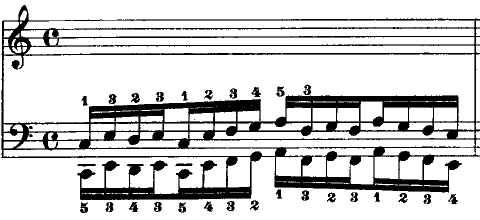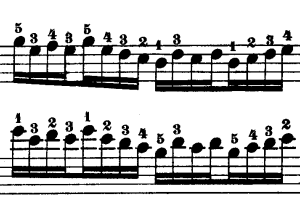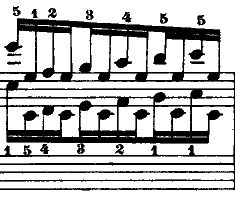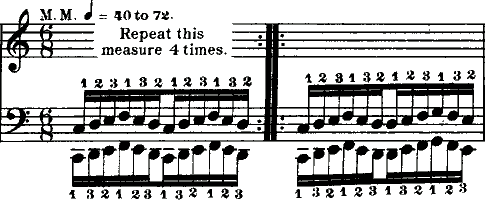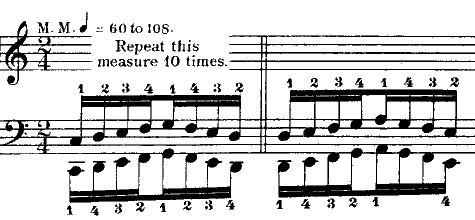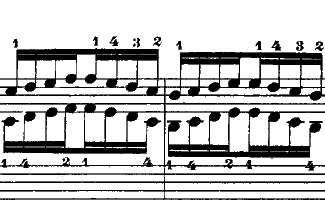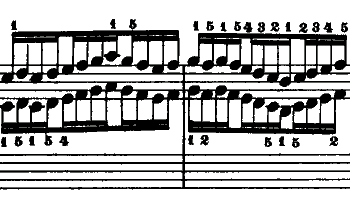

Prelude to the True Beginning
I finally become aware of my confusion.
Yet again, no indication of tempo. This should mean the exercise implies a 72BPM max. Yet again I go online and behold, everyone is at 108BPM. I'm beginning to think everyone wings it when there's no tempo on the sheet. Reading ahead, I realize exercise 39 (scales) demands a 120BPM. I compromise and go at exercise 38 with a 108BPM max.
This is far from the first exercise in which the left hand and right hand move in disparately, but the added thumb skipping presents a bothersome pitfall. It took me three sessions to get it right, but only 10 minutes in each were dedicated to this exercise. I got it at 80BPM and procrastinated. The truth is that this exercise caught me by surprise. It's much harder than exercise 35, which I thought would be the grand decider of my near-future. Looking at what they demand of me, it's easy to assume this to be the case.
I was so mentally ready to ace this exercise in half a session that, having skipped directly to 108BPM, I was beyond frustrated that I couldn't even land one rep cleanly. So I let it simmer with the summer heat. Ultimately, the drive to challenge myself prevailed. I got it right at 108BPM and flipped the page to exercise thirty-nin--
Exercise 38, part 2
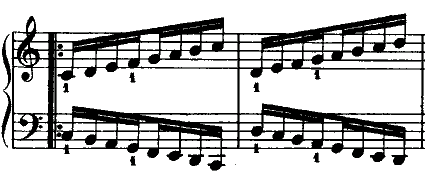

The Concept of perfect evenness
I was so ready to stop thinking about it that I forgot exercise 38 has two pages. Now, by going up the keyboard on one hand and down with the other, they become a perfect mirror. However, the next rep has both hands move up the keyboard, meeaning the jump between reps is different for both hands. This disconnect discouraged me before even trying. Things only got worse when I began: it's hard to look at both hands to make sure I'm starting the new rep properly. So I let the exercise simmer again, this time for much longer.
A week later, with no more excuses to keep away, I finally got back on the piano. Two whole hours over the course of the day, playing this exercise with either hand only, at different tempos, trying to understand my weaknesses. Like all previous exercises, I can play witthout looking at the keyboard when using only one hand. Unlike all previous exercises, I can't do it when playing both hands. I played some more and realized that, somehow, my right hand always landed in the right spot at the start of a new rep, so long as I believed myself
And why shouldn't I?
How long have I been going at this? Playing these mindless exercises to improve dexterity. My fingers always hit the right spots in all other exercises. Why shouldn't they now? Just because I'm faced with a never-seen-before movement? How many times has that happened before?
I kept playing and took mental note of how my right arm, wrist, elbow and shoulder were moving. The distance from one rep to another. I consciously applied the same distances to my left arm. When I believe myself, I land every rep. When my mind drifted, into asking how the hell was I pulling this off, looking back at the keyboard to check if the fingers were really landing on the right keys, suddenly my playing would crumble. It's not the first time this happens, but this felt different. The movements I was employing were charged with greater intent. It wasn't only my fingers or wrists moving. My whole arms, even my body, were part of the process. Moving at the same time, the same distance. Amidst the moments of mental chaos, the answer to the why revealed itself in a mantra that extinguished all doubt.
Perfect evenness.
This is what is meant in the book. This is the way I should have been playing all along. I had always hit the keys with a little too much strength, which always made me tire quicker than I'd like. Thinking about each hand as the opposite of the other rather than as complementary extentions of a whole.
My playing felt gentler. My mind felt lighter. And as I got to the up-down transition, which mercifully allows us a whole measure of pause (image not shown), I slid down without a second thought. And thus I reach the final note, perfect evenness stabilising my thoughts.
The exercise was complete. At 80BPM. Having spent a combined total of 120 minutes of my day on this, I decided to leave 90 and 108BPM to the next day. And in the next day I finally nailed a complete play of exercise 38 at 108BPM in 10 minutes.
Having spent so long playing no other exercises, I decided to do a good old Ex1 to 20 victory lap to reinforce my dominance.
...And immediately fail the transition from Ex1 to Ex2.
My hands were now so used to the transitions in Ex38 that my fingers skip more or less keys than they have to. Nothing that a quick freshening didn't fix, but that's not the thing that made me introspective.
I realized I needed to play every exercise so far the same way I did exercise 38. Lighter, more self-assured, freer.




